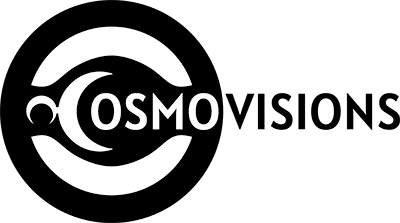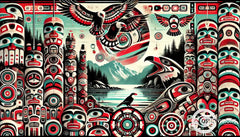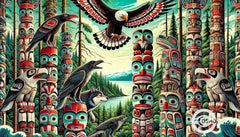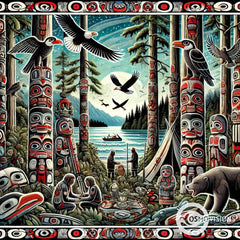Exploring the Rich Heritage of Haida Mythology: Myths and Stories of Raven
Posted by Massimiliano Geraci
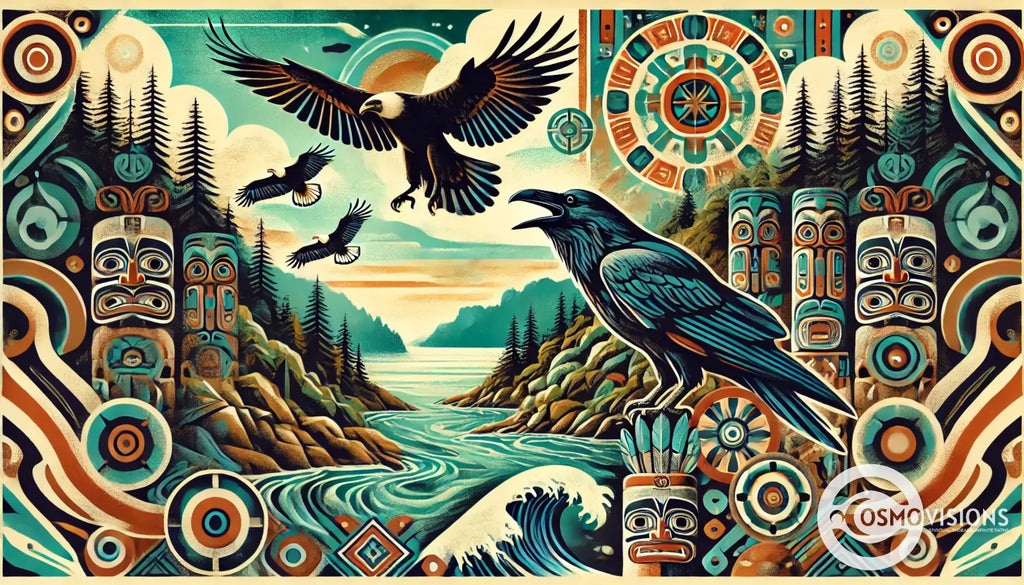
Exploring the rich heritage of Haida mythology reveals a world where every story and myth carries deep meaning. Many people find themselves drawn to these narratives, yet often encounter challenges in understanding their intricacies and cultural significance.
The stories woven by the indigenous people of the Pacific Northwest, particularly those centered around Raven, serve as a bridge between the human and natural worlds, highlighting themes of creation, transformation, and connection.
One fascinating aspect of Haida culture is its pantheon of deities, with Raven often playing a pivotal role as both creator and trickster. This figure's adventures offer insight into the values and beliefs of the Haida people.
Our article aims to demystify these stories for readers by exploring myths like how Raven brought light to the world or released salmon into rivers. By illuminating these tales' significance within Haida Gwaii's natural beauty and cultural landscape—where eagles soar high above ancient forests—we invite you on a journey through storytelling that has shaped generations. Gyhldeptis is a kindly forest goddess.
Discover wonders hidden in plain sight.
What are the Essential Elements of Haida Mythology?
Haida mythology, deeply rooted in the rich tapestry of the Pacific Northwest coast, centers around a pantheon where Raven often emerges as a potent creative force. This mythological framework is a collection of stories that also serves as a complex reflection of Haida culture itself.
Within this narrative universe, deities like Raven and supernatural beings weave together tales that reflect deep connections to nature, showcasing transformative powers over elements such as light and water.
The world is full of magic things, patiently waiting for our senses to grow sharper. - W.B. Yeats
Central to these myths are the motifs of creation and transformation, with Raven acquiring pivotal items like fresh water or sunlight for humanity—acts that underscore his dual role as trickster and cultural hero. His translations, though, are controversial in Haida circles and some have charged him with cultural appropriation.
Through engaging with creatures known to Haida such as bears or eagles, these stories articulate an ethos where kinship with all living beings underlines an intrinsic value system.
Such narratives highlight how Haida Gwaii's natural landscape shapes and is shaped by its people's beliefs—a testament to the enduring legacy of storytelling within Haida society.

Who are the Major Deities in Haida Mythology?
In Haida mythology, Raven stands as a central figure, often depicted as both the creator and trickster. This magnificent bird is renowned for bringing the world into existence and playing pivotal roles in stories of creation, transformation, and teaching.
Through cunning acts, Raven acquired such elements as sunlight to illuminate the previously dark world. Another significant deity is Ta'xet, the god of violent death, who alongside Tia represents dual aspects of life cycles within this rich spiritual landscape.
Eagles also hold a revered place among these mythological beings. Known for their wisdom and strength, eagles are frequently juxtaposed with Ravens within narratives to symbolize balance and duality in nature.
These deities together weave a complex tapestry that reflects deep connections between the Haida people and the natural world around them. Their stories capture fundamental understandings of existence, morality, and humanity’s place within the cosmos.
How do Stories in Haida Mythology Reflect Haida Culture?
Haida myths, rich in the lore of Raven, the Transformer, and magical beings of Haida Gwaii, serve as a mirror reflecting deep connections to nature and community values. These stories weave a complex fabric showcasing respect for both the animal kingdom and supernatural entities that populate the Pacific Northwest Coast.
Through tales where ravens transform and shamans communicate with spiritual realms by clenching their teeth, listeners learn about the interdependence between humans and the environment.
The narratives underscore principles like balance, respect, and stewardship—core tenets deeply embedded within Haida culture.
Central figures like Ta'xet and Tia represent life's cyclical nature—their roles in mythology symbolize creation, transformation, destruction, and rebirth processes integral to understanding seasons' changes on Haida Gwaii. Ta'xet and Tia are death gods among the Haida. Ta'xet rules violent death, while Tia rules peaceful death.
Such stories are not just entertainment but lessons that convey cultural knowledge about living harmoniously within one’s surroundings. They emphasize cooperation among creatures known to the Haidas; whether it be eagle or raven characters displaying sharp wit or profound wisdom guiding first humans from a cockle shell into existence.
Turning to what role Raven specifically plays reveals even more layers of this vibrant narrative tapestry.
What is the Role of the Raven in Haida Beliefs?
In Haida mythology, the Raven plays a pivotal role as both a creator and trickster, deeply embedded within the spiritual and cultural narratives. Esteemed as a central figure, Raven is known for its intelligence and cunning behavior.
This mischievous creature stands at the heart of many stories, shaping the world and human existence by acquiring such crucial elements good life such as light to illuminate the world previously engulfed in darkness.
The tales recount Raven's adventures with wit and guile, redistributing these stolen treasures to benefit humanity.
The cultural hero does not act solely for altruistic reasons; his actions often stem from personal desire or curiosity. Yet, through these quests, Raven inadvertently shapes the environment and society of Indigenous peoples along the Pacific North west Coast of North America.
He brings forth change, innovation, yet also lessons through his antics—portraying moral values intertwined with humor. His dual nature emphasizes balance between beneficial deeds for others and fulfilling individual needs—a key theme in Haida storytelling that mirrors human nature itself.
Moving forward into how this mythology describes creation will further reveal Raven’s significance in bringing about life forms on earth.
How Does Haida Mythology Describe Creation and the First Humans?
Haida mythology unfolds the cosmos's origin through a tapestry rich with supernatural beings and transformative events, placing Raven at the center of creation stories. This mischievous deity, known within Haida culture for its cunning and creativity, played a crucial role in bringing forth life on Haida Gwaii.
According to epic versions of these tales, Raven found beings hidden within a clam shell on the beaches of these islands. With his sharp beak and even sharper wit, he the little creatures and coaxed them out into the world, thus introducing humans to existence.
These first people were integral not just as characters in a story but as ancestors who established the bond between the Haidas and their sacred lands.
Raven's contribution extends beyond this initial act; he redistributed sunlight across the world by releasing it from a tiny box owned by another powerful entity—a tale showcasing how Raven acquired such things necessary for human survival.
The significance of Haida Gwaii transcends its role as mere setting; it is revered as both cradle and crucible of life, where natural beauty converges with spiritual vitality. Here lies the genesis of humanity according to Haida lore and an enduring connection that every tide and tree whisper still speaks of today—a testament to how deeply intertwined are the narratives of people with places they hold sacred.

What is the Haida Creation Story?
The Haida creation story paints a vivid narrative of the world's inception, centered around Raven, a mischievous yet pivotal figure within Haida mythology. This tale unfolds in the majestic landscapes of Haida Gwaii, often referred to as the heartland of Haida culture.
Known for being both a creator and trickster, Raven discovers the first humans hidden inside a clamshell on a beach. With his sharp intellect and curious nature, he coaxes them out into this new world.
This act symbolizes not just the birth peaceful death of humanity but also marks Raven as a cultural hero who bridged the gap between celestial beings and mortals.
Raven Tales serve as meaningful examples of living in balance with nature among indigenous peoples.
Through these stories, Raven often helps humans by teaching them vital skills for survival and enlightening them about social customs. The intertwining tales showcase how Haida beliefs are deeply rooted in respect for both wildlife and natural phenomena—where every element holds an intrinsic value contributing to larger life cycles.
Intricately linked with seasonal patterns observed across British Columbia’s lush landscapes, these myths extend beyond mere folklore; they represent centuries-old wisdom that emphasizes harmony between people and their environment.
How Did the Raven Contribute to the Origin Myths?
Raven, a central figure in Haida mythology, emerges as both the creator and trickster, shaping the world and its inhabitants with cunning intelligence. In tales that span from releasing the sun to bringing the first humans into existence, Raven's actions underscore his importance in origin myths.
His journey to find light involved transforming into various forms, showcasing his transformative nature—a key aspect of many Indigenous peoples' stories across the Americas. By stealing light from a distant house where it was hoarded by its keeper, Raven made daylight accessible to all.
This pivotal moment illustrates how Raven's quest for illumination changed Earth’s landscape forever.
Following this transformative event, Raven found himself on the beaches of Haida Gwaii where he discovered beings encased within a clamshell. With sharp wit akin to using kaiti—a tool sharp as a knife—he coaxed them out, introducing humans to their new world.
Through these acts of clever benevolence and sometimes mischievous deeds aimed at filling up parties he was throwing or simply satisfying his relentless curiosity and appetite for adventure—Raven laid down the foundational narratives for human interaction with the world in Haida lore.
Such narratives highlight Raven's critical role and encapsulate broader themes of transformation, creation, and enlightenment pivotal in understanding human origins through indigenous lenses.
What is the Significance of Haida Gwaii in Creation Myths?
Haida Gwaii emerges as a pivotal landscape in the tapestry of Haida creation myths, embodying the convergence where the physical and spiritual landscapes meet. Esteemed as the birthplace within one story these narratives, it is here that Raven, perceived across numerous Indigenous peoples native languages of the Pacific Northwest Coast including Tlingit, Tsimshian, Haida discover humans hidden inside a clam shell.
This land serves as a backdrop and acts as a central character, integral to these origin stories, holding profound significance for understanding how Haidas perceive their connection to nature and spirituality.
Furthermore, nurturing this deep bond with Haida Gwaii are tales wherein creatures known to the Haida like Eagle and supernatural beings play crucial roles in shaping both the natural world and societal structures.
The islands stand testament to this enduring relationship between people and place; they encapsulate histories encoded in epic poetry passed down through generations. Through oral tradition reinforced by carvings seen on towering totem poles around Masset or intricate artworks housed at institutions like American Museum of Natural History or University of British Columbia’s collections featuring Bill Reid's "The Raven and The First Men", every aspect echoes the sacredness imbued within these shores – solidifying its unrivaled status in hosting and actively participating in creation myths that continue to guide living traditions among one of indigenous peoples’ most complex reflections of their culture.
What are the Most Popular Myths and Stories in Haida Culture?
One of the most celebrated stories within Haida culture centers on the Raven Acquiring Light, a tale where this mischievous creature known to the Haida brings light to humanity. This story showcases Raven not just as a sly being but underscores his role as a cultural hero whose actions have deep ramifications for both the natural and human worlds.
The intricate connection between the Haida and these narratives reflects in their art, ceremonies, and social structures, painting Raven as both creator and trickster.
Tales of supernatural beings also enrich Haida storytelling, with entities like Eagle and Bear God playing pivotal roles. These characters do not solely exist within mythical dimensions; they embody essential life lessons on coexistence, respect for nature, and community values.
Such myths serve dual purposes: recounting history while guiding future generations through rich oral traditions that have been preserved diligently by elders. Through these stories, listeners engage with complex reflections of themselves mirrored in tales passed down over centuries.
Raven often helps humans in our encounters with other beings of the world.
What is the Story of the Raven Acquiring Light?
The story of the Raven acquiring light highlights the Raven's role as both a trickster and cultural hero in Haida mythology. The tale begins with the world engulfed in darkness, where the only light existed hidden away by a selfish old man who refused to share it.
Using his wit, the Raven transformed himself into a pine needle, which was then ingested by the old man's daughter, ultimately leading to his birth as her child. As a beloved grandchild now, he cleverly persuaded his grandfather to let him play with the light – first as a shining ball that represents the moon and then as another that becomes our sun.
Through cunning actions, Raven escaped with these sources of light and released them into the sky, illuminating Earth for all its inhabitants.
This narrative marks Raven's importance in bringing illumination to humanity and intricately ties together themes of transformation, intelligence overcoming greediness, and altruism.
It showcases how Haida myths serve as complex reflections of one’s own self and culture while emphasizing deep connections to natural elements like moonlight and sunlight. Echoing through time from narratives passed down orally among generations before being documented by scholars such as John R.
Swanton, this haida legend underscores Haida values intertwined within their pantheon—the weave of supernatural beings highlighted by tales where entities like ravens play pivotal roles beside humans and nature itself.

What are the Tales of Supernatural Beings in Haida Storytelling?
Haida storytelling shines with tales of supernatural beings, weaving a deep connection to the natural world. Shamans, pivotal figures in Haida culture, could speak in unique voices by clenching their teeth, channeling the wisdom and power of these otherworldly entities.
These tales often feature Raven, not just as a trickster but as a cultural hero who brought the first humans into existence from a clamshell. This act alone highlights Raven's dual nature as both benefactor and ravenous debaucher, always at the heart of Haida mythology.
Supernatural beings in these stories embody complex reflections of human selves and societal norms, usually teaching valuable lessons through counterexamples. They inhabit a world where everything has invisible spirit and significance—from the majestic eagles that soar above Haida Gwaii to every creature that fills its rich landscapes.
Through such narratives involving eagles and ravens prominently, Haida myths form an intricate web linking people to animals, plants, and supernatural entities alike. Such storytelling preserves traditional knowledge and reinforces the tribe’s reverence for all aspects of their environment.
How are Seasonal Patterns Depicted in Haida Myths?
Transitioning from the tales of supernatural beings, we explore how seasonal patterns are masterfully interwoven into Haida myths. These stories offer rich imagery and profound connections between the rhythms of nature and human experience.
The changing seasons play a crucial role, symbolizing life cycles, transformation, and renewal. Raven, a central figure in Haida mythology and cultural hero, often interacts with these natural cycles in ways that highlight their significance to Haida life and spirituality.
Seasons dictate not just the physical but also the spiritual landscape of Haida mythology. For instance, winter is not simply a cold period but a time filled with storytelling where lessons from past generations are passed down through myths.
Spring brings rebirth; many stories involve Raven releasing or discovering objects like light or water at this time, signifying new beginnings. Such narratives serve as metaphors for growth and change within individuals and communities alike—echoing the intimate connection between Haida people and the land they hold sacred. The Haida myths and legends about killer whales describe them as supernatural beings who essentially ruled the underworld. In Haida culture, the underworld refers to the ocean and everything within it. Killer whale had their own villages beneath the waves, equivalent to the Haida villages on the surface, with longhouses lined up with each other.
In every Haida myth there lies a season's heart—a cycle of death and rebirth that teaches us about resilience in face of change.
How Do Haida Mythological Creatures Relate to Nature?
Haida mythological creatures emerge from a deep connection between the Haida people and the natural world, reflecting an intricate relationship that transcends mere stories. The raven, often helping humans, stands as a cultural hero in many tales, embodying both the trickster spirit and a protector of nature.
Eagles and ravens dominate these narratives, not just as prominent figures but also symbolizing the profound bond between Haida culture and its surrounding environment. These creatures appear in stories that capture the essence of natural phenomena – from seasonal changes to explaining why certain landscapes on Haidas believe Raven shaped them with his actions.
In these myths, supernatural beings like eagles and ravens are not random characters; they carry significant weight in conveying how closely tied to nature Haida's spirituality truly is.
Through their actions – whether it's Raven acquiring light for the world or Eagle shaping geographic features – each story serves as a complex reflection of one’s own self within the universe.
The symbiotic relationship highlights respect for all living aspects, underlining indigenous beliefs where every creature has its role and significance within Earth’s tapestry, echoing timeless reverence towards nature by Haida Gwaii inhabitants.
What is the Connection Between the Haida and the Natural World?
The connection between the Haida and the natural world is deeply rooted in their mythology, where entities like the raven and eagle hold significant cultural hero status. These creatures are not just animals but revered beings that embody qualities essential to Haida spirituality and societal values.
Through stories passed down generations, such as those documented by Terri-Lynn Williams-Davidson and depicted by renowned artists like Charles Edenshaw, these animals are shown as protectors, providers, and sometimes tricksters who play pivotal roles in shaping the environment the Haida people call home.
Nature serves as a canvas for the Haida's rich tapestry of myths, with each element - from towering cedar trees used in constructing canoes to the vast Pacific Ocean that cradles Haida Gwaii - playing a vital part in their creation stories and daily lives.
The reverence for nature is evident through practices that reflect a symbiotic relationship; one where respect for every creature and geological feature guides activities such as fishing, hunting, and gathering.
This deep-seated bond highlights an understanding of balance within ecosystems long before conventional conservation efforts took shape. It’s this ethos that transforms nature from mere backdrop to an active participant in the ongoing story of the Haida people.
Why are Eagles and Ravens Prominent in Haida Stories?
Eagles and ravens hold a significant place in Haida mythology, representing more than just the indigenous peoples’ admiration for these majestic birds. In many stories, the raven emerges as a master trickster and a cultural hero, shaping the world with cunning wit.
This bird often helps humans by transforming landscapes and bringing essential elements such as light to humanity. Its actions reflect deep spiritual beliefs about transformation and interconnection with nature.
Similarly, the eagle stands as a symbol of power and sovereignty, embodying qualities that Haida people admire: strength, intelligence, and leadership. Together, these birds encapsulate important aspects of life and spirituality in Haida culture.
Their prominence in tales is not solely attributed to their physical or character traits but also to their roles within the pantheon (religion) as carriers of messages between the supernatural and humans.
Ravens acquire light usually by counterexample; they fill up parties with laughter or wisdom through their mischievous deeds or clever tricks. On another hand, eagles are seen flying high above Ninstints' ancient poles signifying their watchfulness over territories while denoting respect among clans showcasing features American Indians hold dear—especially human faces carved on totems which stand testament to raven stories passed down generations.
Discussions on how these mythological creatures relate to natural phenomena explore this intricate relationship between Haida mythology and ecology.
Where Can One Learn More About Haida Mythology?
Exploring Haida mythology becomes enriching through a selection of books and museum exhibits that thoroughly examine this indigenous cultural treasure. Recommended reads include works by scholars such as Robert Bringhurst, whose writing captures the essence and intricacies of the Haida pantheon.
Anne Cameron's stories offer vivid retellings that breathe life into mythological characters like Raven, showcasing their roles as both tricksters and culture heroes. These authors employ rich imagery and detailed explanations to make Haida myths accessible to readers seeking deeper understanding.
Museums also play a crucial role in bringing Haida mythology closer to enthusiasts outside the United States. Exhibits feature artifacts that embody the intricate relationship between the Haidu people, their deities, and nature itself.
Through these displays, visitors gain insights into how eagles and ravens are not just birds in these stories but symbols with profound spiritual significance. Learning about Haida mythology is further enhanced by engaging with external links available on platforms like Wikipedia, which connect users to a wide range of resources for an even more comprehensive exploration.
The next section will explore how these mythologies reflect broader themes in Indigenous cultures across the Americas.
What Books on Haida Mythology are Recommended?
Haida mythology, encompassing the tales and cultural ethos of one of the indigenous peoples, holds vital insights into a complex reflection of human connection with nature and spirituality. For those eager to explore this rich heritage, several books serve as essential guides, weaving through the narratives of ravens, shamans, and the cosmology that defines Haida belief systems.
1. "A Story as Sharp as a Knife" by Robert Bringhurst enlightens readers on the Haida language's nuances and its storytelling traditions. This book explores the heart of Haida oral literature, offering a comprehensive translation and analysis of these profound narratives. Bringhurst's work sheds light on how shamans could speak volumes without uttering a word, employing only their voice by clenching their teeth - a testament to the profound spiritual practices among Haida people.
2. "Raven Travelling: Two Centuries of Haida Art" takes an artistic journey through time, presenting exquisite pieces that tell more than just myths but encapsulate an entire way of life where ravens often help humans, acting as cultural heroes rather than mere figures in stories. This volume showcases over two hundred years of artistry, revealing how these creations serve as tangible narrations of myths deeply ingrained in Haida culture.
3. "The Raven Steals the Light" by Bill Reid and Robert Bringhurst combines narrative elegance with captivating artwork to recount several beloved myths from the Haida tradition. Among them is another story fascinatingly illustrating why raven can be considered both a ravenous debaucher and always a cultural hero—a figure who filled up a party he was throwing simply because he needed to fill it with light and joy.
4. "Haida Monumental Art: Villages of the Queen Charlotte Islands" authored by George F. MacDonald provides readers with insight into significant cultural landmarks tied directly to mythological narratives like those involving eagles and ravens or supernatural beings within Haida storytelling. The book thoroughly explores how these massive artistic undertakings are not just expressions of aesthetic endeavor but are also deeply imbued with meanings that reflect tales passed down generations.
5. "That Which Makes Us Haida—the Haida Language" by Jordan Lachler is crucial for anyone interested in understanding not just the myths but also the linguistic vessel that carries them through time. By focusing on the intricacies of how stories are told—in particular, those featuring supernatural beings or depicting seasonal patterns—this text illuminates how language acts as a living repository for culture.
6. The Governor General's award-winning book “Potlatch as Pedagogy: Learning Through Ceremony” co-authored by Sara Florence Davidson and Robert Davidson extends beyond myth directly into modern-day applications regarding teachings embedded within Hadia stories including creation myths reflecting deep respect for nature’s cycles witnessed within their national territories such as Haida Gwaii.
As scholars journey through these texts, they uncover layers upon layers of meaning within each tale—an exploration reminiscent of peeling back earth to reveal both roots grounding present reality in its past while branches reach out intertwining individual identity with collective legacy voiced through each narrative thread spun since creation's dawn.
Which Museums Feature Haida Mythology Exhibits?
Museums around the globe celebrate the rich Haida mythology, showcasing exhibits that explore its complex narratives and characters. These institutions serve as bridges, connecting visitors to the indigenous peoples of the Americas through art, spirituality, and history.
1. The Royal BC Museum in Victoria, Canada, presents a comprehensive collection of Haida artifacts. Here, visitors discover totem poles that reach towards the sky, intricately carved by skilled hands to tell stories of eagle and raven clans. The museum also offers insight into how these carvings serve as a complex reflection of one's own self within the community.
2. American Museum of Natural History in New York features an exhibit where the cultural depictions of ravens come alive. Attendees can explore how the raven often helps humans through multimedia presentations that blend traditional storytelling with modern technology.
3. Canadian Museum of History in Gatineau integrates Haida mythology into its broader exhibits on Indigenous cultures. One section highlights the role of the raven as both a creator and trickster figure—a dichotomy that reflects its importance across various tales where it alternates between being a ravenous debaucher but always ends up contributing significantly to Haida life.
4. The Haida Heritage Centre at Ḵay Llnagaay in Haida Gwaii provides perhaps the most immersive experience directly on ancestral land. It offers not just exhibits but also live demonstrations and workshops where one can see artists breathe life into cedar wood, transforming it into pieces that house for humans stories both ancient and living.
5. Vancouver Art Gallery frequently features exhibitions on Indigenous art, including those focusing specifically on Tlingit and Tsimshian influence alongside Haida contributions. Past exhibitions have showcased everything from classic totem poles to contemporary interpretations by Haida artist who give power anew to old myths through visual arts.
Each museum stands as a testament to how closely tied the Haida are with their environment and spiritual beliefs, inviting everyone from anthropology enthusiasts to spirituality seekers for an educational journey into one of North America’s oldest living cultures.
How Can External Links Enhance Understanding of Haida Culture?
Exploring Haida culture extends beyond the pages of books and museum exhibits. The internet serves as a gateway to a wide array of resources that deepen our understanding of this rich heritage.
1. Online galleries feature Haida art, showcasing intricate carvings and designs that reveal stories of the indigenous peoples, their spirituality, and their interconnectedness with nature.
2. Websites dedicated to Haida mythology offer insights into the roles of major deities, including the highest being in all Haida beliefs and Raven, the trickster who operates within a complex moral ground.
3. Academic journals accessible through educational platforms provide detailed analyses of how stories in Haida mythology reflect upon and preserve Haida culture over centuries.
4. Video documentaries available online bring to life the oral traditions of Haida storytelling, with elders sharing myths that explain natural phenomena and cultural practices.
5. Digital archives house collections of photographs, historical documents, and interviews with Haida people, offering a tangible connection to past generations and their ways of living.
6. Social media groups facilitate discussions among enthusiasts and scholars, fostering a community where individuals can share knowledge and insights about various aspects of Haida life.
7. Virtual tours of regions like Haida Gwaii allow users to explore significant sites mentioned in creation myths without physically traveling there.
8. E-learning courses offer structured lessons on indigenous cultures, including modules specifically focused on Haida mythology, enabling a deeper comprehension through guided study.
9.Blogs written by anthropologists and spiritual practitioners present personal perspectives on how timeless Raven often helps humans or how seasonal patterns are depicted in myths.
10. Databases compile research papers that examine the influence of supernatural beings in Haida stories or discuss the significance of animals like eagles and ravens in said narratives.
Each digital resource peels back layers of history and cosmology, inviting users to engage directly with the elements that make up a party central to Haida culture – from majestic totems to mesmerizing tales spun around firelight gatherings where people used stories as a means to teach and entertain.

